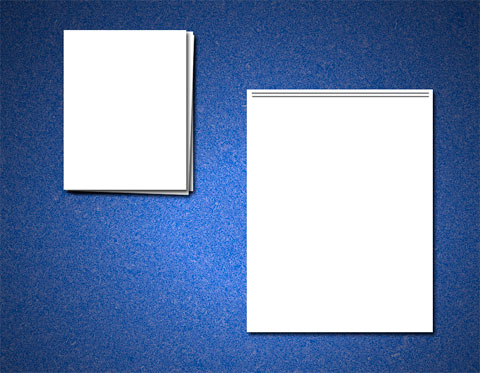Take a New Sheet of Paper
My very first pattern, March 2004.
Context
Today the amount of time spent to operate the computer compared to the productive hours spent on creative work on the subject of interest gravitates badly towards the unproductive part of the equation. One reason is the tools-centered approach of many user interfaces. In order to hammer a nail into the wall of your house, you have to move the house into the hammer, rather than going into your house and take the hammer and nails with you.
Problem
Typically documents have a specific file type which is associated with a certain tool. The computer keeps track of this relation for all documents in order to present the right tool for each document once the user chooses to edit the document. In this paradigm it is not possible to create a generic document without a type.
Forces
An insight struck the user and she wants to write down her idea in a straight forward way for later use.
On the other hand, the computer has no notion of the ideas of its user. Documents are stored as files of a specific file type. Further down the road this information is used to present the appropriate set of commands to edit the document.
Solution
The user creates a new document by taking one sheet from a block of blank sheets.

After that the user can choose from a small set of tools like e.g. TEXT for typing, PEN AND RULER for drawings, or a CALCULATOR for mathematical tables. The computer is required to offer the applicable commands for a selected piece of content.
Examples
Xerox Star
The Xerox Star came with a fixed set of tools. This makes it possible to create a new document and place content of all (possible) kind on the document.
OpenDoc
OpenDoc has the following basic concept for all documents: The user can create a new generic document by opening a template document. Second step is to create a frame of a specific type on the document. Typical types are something like TEXT FRAME, SPEADSHEET FRAME, or DRAWING FRAME. Depending on the selected frame the corresponding commands are presented to the user.
RagTime
RagTime is an office application that offers in principle the same behavior as OpenDoc. Once RagTime has been launched the user creates new documents and puts frames of the desired type on the document.
Template Concept of Apple Lisa
To create a new document of a specific type the user has to use a stationery pad. This is a special kind of document that acts like a template for new documents. Opening a stationery creates a new document by duplicating the content. It is not necessary to launch the tool before a new document can be created.
This concept is still in used by many desktop systems.
StarOffice
Once StarOffice has been launched no other launching of StarOffice modules is necessary. The user can create a new StarOffice document for any StarOffice module while working on any kind of StarOffice document.
The StarOffice Quickstarter takes the burden of the user to launch StarOffice when needed. Instead StarOffice launches automatically along the Windows start sequence.
References
Müller-Prove, Matthias: Vision and Reality of Hypertext and Graphical User Interfaces. https://mprove.de/visionreality/